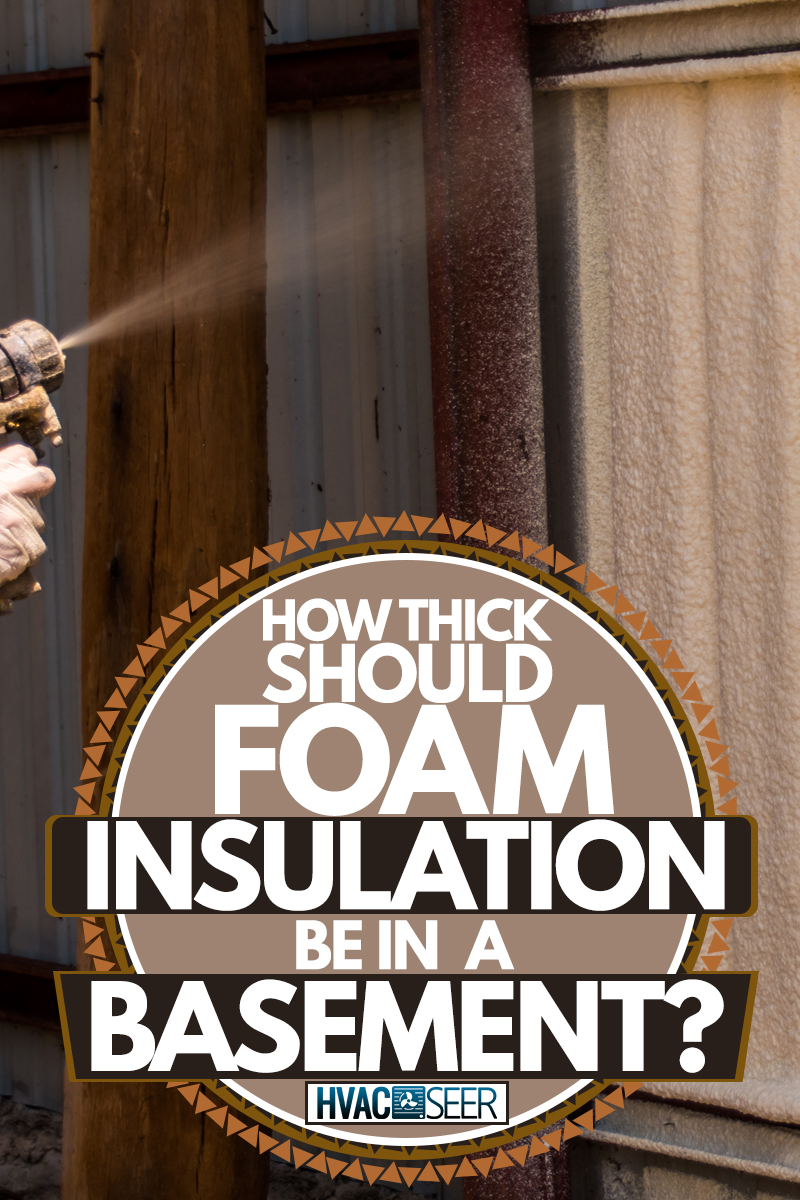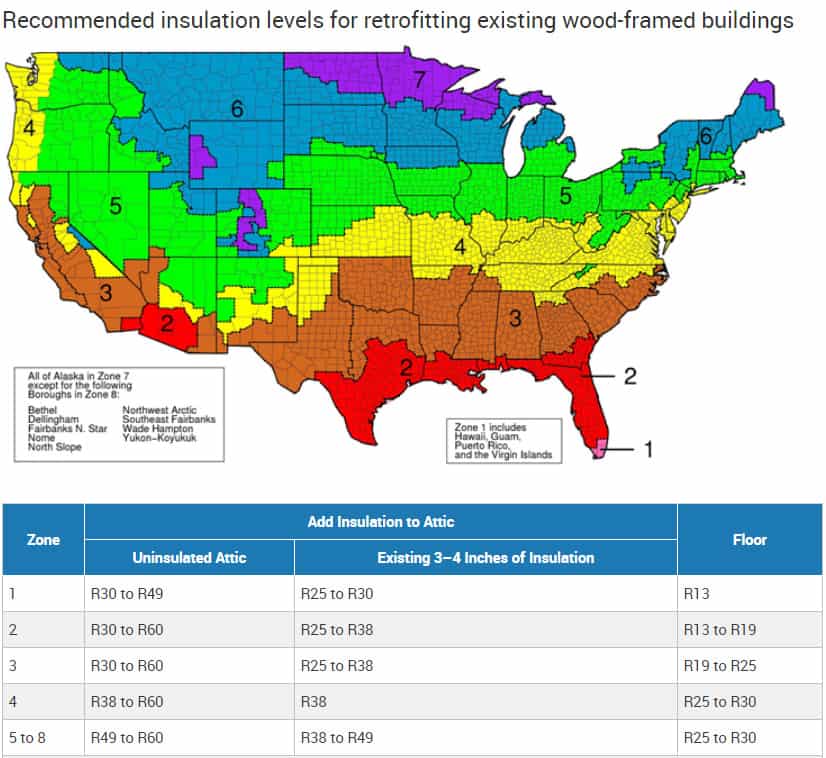If your basement feels stuffy, stays damp, or seems a bit smelly, you might be wondering how to remedy these issues. Is the basement cold in the winter? Are your home's heating bills too high? Insulating your basement is a good way to help with all these problems. But how much insulation do you need? There is no universal one-size-fits-all answer to this critical question, but we've researched foam insulation to help you to install the right thickness in your basement.
The thickness of foam insulation in basement walls will range between two to seven inches, depending on where you live and whether you use open or closed-cell spray foam insulation. Climate, temperature fluctuations, and humidity all affect the amount of insulation you'll need, as well as the type of heating you use to heat your home.
That sounds like a lot to consider to determine insulation thickness. Not to worry, because we've got all the answers to your questions and more. Please continue reading as we delve into the difference between open-cell and closed-cell insulation and give you the tools you'll need to determine the right thickness for your basement.

Determining The Thickness For Foam Insulation In Your Basement
Before you select foam insulation for your basement, determine the climate zone for your home. This handy chart factors in things like your area's climate, weather fluctuations, and humidity to arrive at an appropriate insulation level. It also factors in the heating system you use to heat your home.

Image and table by EnergyStar.gov
What Is The R-Value For Spray Foam Insulation?
While determining your home's climate zone, you likely recommended a particular R-value for insulation. The R-value measures the resistance to heat loss. The R-value level for basement walls can vary from 11 to 25. To reach the recommended R level, divide the recommended R-value by the R-value of your particular foam insulation.
The two types of spray foam insulation
Spray foam insulation comes in two types: open cell and closed cell.
Each type has its advantages and disadvantages, as explained below. Open-cell R-values typically run between 3.5 to 3.6. Closed-cell foam insulation runs between 6.0 to 6.5. For example, if you decide to use closed-cell spray foam insulation with an R-value of 6.5, you likely live in Zone 5, and your house uses an LPG furnace to heat the home. The recommended R level is 25. To achieve the recommended R-value level, you'll need 3.84 inches of insulation (25/6.5=3.84).
Once you have determined what the appropriate R-value is for your home, you will need to decide whether you want to use open-cell or closed-cell foam insulation. In addition to cost considerations, you will want to consider how each of these performs under different circumstances to choose the right kind for your particular application.
Insulation serves multiple purposes, and you need to know what you're trying to accomplish with insulation to help determine which type of spray foam to use in your basement. Insulation can primarily:
- Prevent the loss of heat through the basement walls. The warm air in the home sinks to the basement and then migrates through the walls to the outside -due to the pressure differences between the inside and outside of the house. Insulation acts as a barrier to the transfer of heat from indoors to outdoors.
- Help to keep moisture out of the basement. Condensate will form on the outer basement foundation walls due to the temperature differential between the colder walls and the warmer interior atmosphere. Insulation can keep moisture from physically traveling to the wall and wick the moisture from the walls.
Some of the considerations for each type of insulation are as follows.
Closed-cell spray foam insulation
Let's take a look at the typical characteristics of this type of insulation.
- Generally more expensive than open-cell insulation.
- Has a higher resistance to heat loss than open-cell foam and is more suitable for areas that require higher levels of insulation based on your climate zone.
- More rigid than open-cell foam. It can help reinforce structures but can also make it more challenging to insulate hard-to-reach areas.
- Doesn't allow passage of moisture; therefore provides a better vapor barrier and provides more protection from moisture.
Open-cell spray foam insulation
As for this type of insulation, it's usually characterized by the following -
- Less expensive than closed-cell foam.
- More flexible. It expands, trapping air as it hardens, which makes it easier to insulate hard-to-reach areas.
- Has a lower R-value and is better suited for areas that require less insulation based on climate zone.
- Better suited for climate zones that experience frequent temperature fluctuations.
- Penetrable by water; therefore, it is of a barrier not as good for vapor and moisture.
Benefits Of Insulating Your Basement
Regardless of which spray foam you select based on your climate zone and intentions, the benefits of insulating your basement include:
- Improving your home's energy efficiency and reducing your heating bill by keeping the warm air in and the cold air out.
- Getting rid of the damp, musty feel by eliminating moisture build-up.
- Protecting your home from mold (and the expensive cost to get rid of it).
- Eliminate that foul smell that hangs in the air.
Can You Spray Insulation Yourself?
Spraying foam insulation yourself versus hiring a professional depends on whether you're willing to invest the time and effort required and whether it is cost-effective to do so. Open-cell foam costs between $1.00 to $1.20 per square foot at 1-inch thickness. Closed-cell spray foam costs from $1.25 to $1.50 per square foot at 1-inch thickness. You can buy the spray gun as well as the foam insulation at most major home improvement stores. The cost of a good quality spray gun and related equipment will be between $400.00 to $800.00.
Don't forget personal protective equipment like appropriate masks and gloves. Spray foam can be toxic if it makes contact with your skin or if you inhale it. You can get adequate face protection and gloves for under $100.00. Alternatively, expect to pay between $.35 to $1.50 per board foot to hire a specialist to do the job for you.
Is insulating the basement ceiling worth it?
As you prepare to insulate the basement walls, you may look up and wonder whether you should also insulate the basement ceiling. The answer to this question depends on how you plan to use the basement. Originally, basements housed the furnace and other pipes and equipment. A basement was also a useful storage location. As time passed, the basement became an extension of the living space. Today, it is not unusual for homeowners to transform a basement into man-caves, game rooms, home entertainment theaters, or other leisure uses.
Insulating your basement ceiling will help prevent loss of heat from the upper levels of your home. An insulated ceiling helps make your heating more energy efficient by preventing the warm air from sinking into the basement and preventing the cold air from traveling up into the living quarters of your home. The net effect, however, is that your basement will get very cold and uncomfortable to use for anything other than storage. So, if you plan to spend any significant time in your basement, it probably doesn't make sense to insulate the basement ceiling.
Summary
To summarize, the thickness of foam insulation in the basement is determined first by your climate zone (and it's particular weather, temperature fluctuations, and humidity). Next, factor in the home's heating system, and whether you choose to use an open-cell or closed-cell spray foam insulation for the R-value of the particular insulation material you choose to use. Finally, now that you know the thickness required, you can approximate the cost and decide whether to do-it-yourself or hire a professional.
